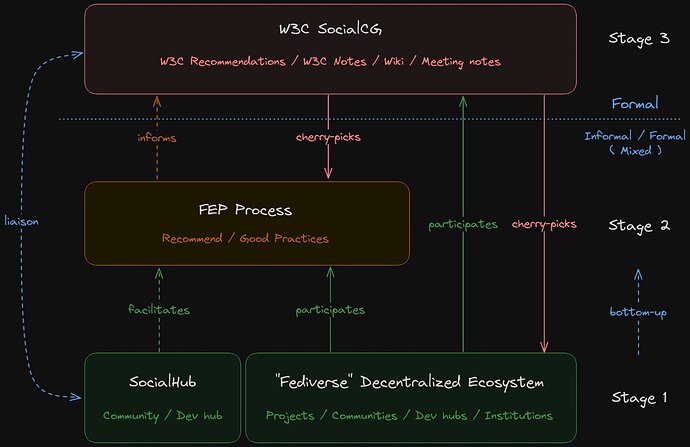In order to avoid misunderstandings on the nature and role of the FEP Process with regards to Fediverse ecosystem evolution, I think we need to further clarify the position of the FEP and how SocialHub relates to it.
For the 3-stage Standards Process proposal, I already mentioned to @stevebate and @evan who had concerns, that SocialHub is just a facilitator of the process, and in no way a gatekeeper. And also that, while there’s a default discussion thread at SocialHub for each FEP, authors may choose to collect feedback via any other channel and avoid forum participation entirely.
The FEP’s positioning is not clear enough. For example for the Content Licensing FEP by @TimBray I had to give clarification in the thread, and then finding direct references to my posts, give more clarification that I’m just facilitating the process, independently from the nature of any of the content of the FEP, which is primarily where the author wants to bring up a subject for consideration.
Especially that last reference is a good example of how social media dynamics can take a life of their own, and completely misrepresent the nature of the FEP, and the hard work of the volunteers that keep it going.
There are more FEP’s that are almost certain to raise controversy and heated discussions. Such as the PhotoDNA Attestations FEP, where I felt obliged to highlight the merely facilitating role of the FEP process.
Clarify positioning
Avoiding confusion on FEP’s role in the standards process is a requirement. What can we do to improve it further?
My thinking is that at minimum there should be a very concise summary. A TL;DR of the process that can be dropped as a prominent disclaimer at any place where quickly-skimming social media eyes ![]() can jump to wrong conclusions:
can jump to wrong conclusions:
- Displayed at the top of the FEP repo’s README.
- Included in a topic template for discussions in Standards > Fediverse Enhancement Proposals
Also @how, I think it is important that FEP topics are reassigned to the @system user, so they are clearly not in the name of the facilitator that may cause confusion and these people being targeted.
What other ideas do you have to bring clarity?
Is the Process complete?
Another aspect that deserves attention is asking whether the FEP Process is watertight. It is fine that the FEP is facilitating and strives to be as open and inclusive as possible. But what kind of submissions should it not be open to? What are the limits to that? And if a particular FEP proposal is highly controversial, what consensus needs to be sought in the broader community to finalise it? Can it even be finalised if there’s no satisfactory solution? Should it be possible to finalize in that occasion?
